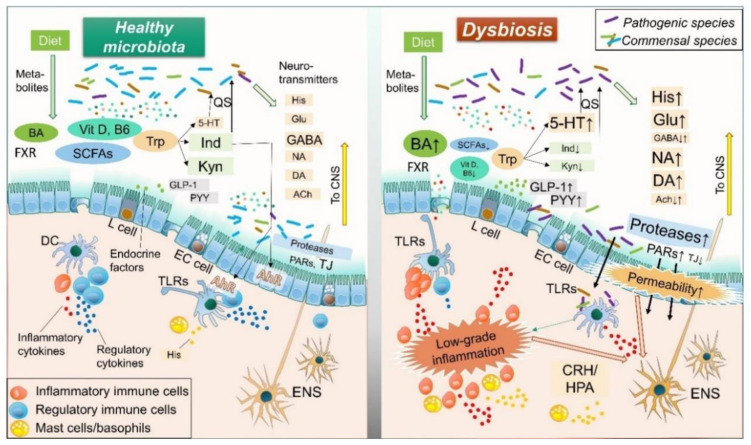Figure 2.
Mechanisms of dysbiosis-mediated intestinal dysfunction in IBS. In dysbiosis related to IBS, both the quality and quantity of microbial metabolites (BA, SCFAs, Vit D, B6, Trp-related), neurotransmitters (His, Glu, GABA, NA, DA, ACh), compounds (TLR ligands), neuroendocrine factors (GLP-1, PYY), and protases are significantly altered as compared with those in a healthy condition. In addition, activated 5-HT with weakened Ind and Kyn signaling can be observed in the Trp pathway. These alternations potentially increase mucosal permeability, while microbial products (TLR ligands, etc.) or antigens can easily penetrate into sub-mucosal areas and stimulate immune cells, thus inducing low-grade inflammation. Prolonged mucosal inflammation and some microbial products directly or indirectly influence ENS and CNS functions through CRH/HPA, GI motility alteration, and hypersensitivity as part of the pathogenesis of IBS. BA, bile acids; SCFA, short-chain fatty acids; Vit, vitamin; Trp, tryptophan; QS, quorum sensing; 5-HT, 5-hydroxytryptamine; Ind, indole; Kyn, kynurenine; His, histamine; Glu, glutamine; GABA, γ-aminobutyric acid; NA, noradrenaline; DA, dopamine; Ach, acetylcholine; GLP-1, glucagon-like peptide-1; PYY, Peptide YY; AhR, aryl hydrocarbon receptor; PARs, protease activated receptors; TJ, tight junction; TLRs, toll-like receptors; EC cells, enterochromaffin cells; CRH/HPA, corticotropin-releasing hormone/hypothalamic-pituitary-adrenal axis; ENS; enteric nervous system; CNS; central nervous system.

